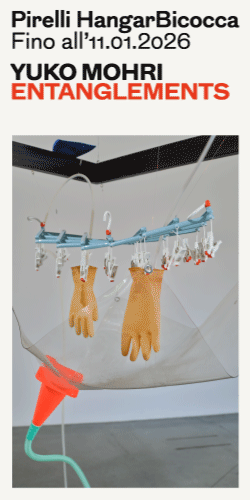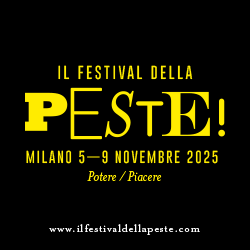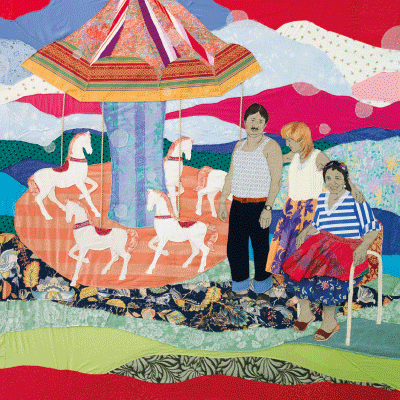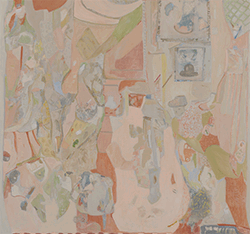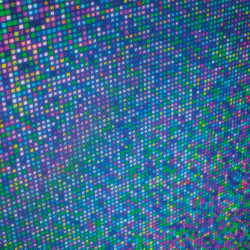[nemus_slider id=”72838″]
—
A Mind of Winter
Curated by Giorgio Pace and Rita Selvaggio
Produced by Giorgio Pace Projects
Chesa Planta, Mulins 6 Samedan
Switzerland
Artists: Karla Black, Louise Bourgeois, Enzo Cucchi, Enrico David, Cerith Wyn Evans, Jacques Henri Lartigue, Goshka Macuga, Fausto Melotti, Marisa Merz, Karen Kilimnik, Yan Pei-Ming, Paola Pivi, Ugo Rondinone, Sterling Ruby, Paloma Varg,a Weisz Not Vital, Sue Williams
—
The title of the exhibition is taken from the opening line of ‘The Snow Man’, a short poem by Wallace Stevens (1879-1955) that can be heard in old archive recordings. The lines, which convey an idea of ‘becoming’, are read by Stevens himself, in an enigmatic and breathy voice. A penetrating, limpid and crystalline voice, the voice of a tenor and not a baritone, as one might expect from his corpulent build, that, year after year, grew steadier and calmer. Always very attentive to the importance of circumstances, to the coercive influence of time and place, and drawn to the rhythm of the seasons, the American poet’s idea of North is a mental state, a process. The North is the space in which it is possible to look at things as they are.
With calm and at an apparently even, unshaken pace, between alliterations and assonances, syntactic arches and naves of silence that enhance the texture of the sound, Stevens’ poetic thought springs straight from the essence of its subject, from life, reality and the imagination, and by subtractive force breaks down and reassembles things into the experience that we have of them, into what Paul Valéry called ‘the theatre of the mind’. Between the wisdom of speech and the sorcery of song, a mind of winter also reflects the period of metaphysical disillusion, of tactile joy, that leads to the awareness of a naked reality in which things are indeed seen exactly for what they are. The setting of the exhibition has the non-colour of cold – or rather ‘the color of ice and fire and solitude’ – and expresses an idea of winter and the North in which people, clouds and landscape, air and light speak of a radical nakedness of being. That of the winter is a mind that observes the far end of the year and its harsh morning. This winter and whoever lives in it come to nothing: the childish horizon where all things end, a sense at one and the same time puerile and wise, senile and new-born. Only at the stroke of midnight does the snow man come to life. Then the night is not all empty and the world is turned upside down. Even the words used to describe it change.
When little is left of everything, the mind of winter is what is needed to see and sustain things in their dazzling reality, and the glimmer that dawns not beyond the winter and the night but within them, like a light that is lit on the inside, is truly a singular mirage.
The winter is a season of short days and long nights. It is a time in which the land lies under a blanket of snow and the sun has no heat, life has withdrawn from the earth and its force is dormant in seeds. The element of winter is water, what ancient Chinese philosophy called ‘old yin’, the cold darkness; its feeling is black while its period of the day is the night-time.
The Element of Light, created by Thierry Dreyfus for the occasion, is a luminous device that allows visitors to find their way in this long night. With its functional design it interprets the serene part of darkness and allows them to perceive the mutation of a formless reality into a pure and settled geometric shape. Held in the palm of the hand, this small and glowing object lends power to the sight and obliges the visitor to observe the works from so close-up and with such care that the act of seeing produces an almost tactile sensation. Where the shadow thickens and directions link up, in a sort of gap in time, the works on show reappear, from time to time, in a place and at a moment that have no relationship with the where and the when in which they had previously vanished.
Rita Selvaggio
—

The route through the exhibition starts with a group of images of winter by Jacques Henri Lartigue (1894-1986), pictures taken in the mountains of the Engadine, a landscape that completely bewitched the famous photographer for the whole of his life and career. To these, at the Chesa Planta, a museum devoted to the culture of living, is dedicated the special space of the former library, housing the cultural archives in which the rich cultural history of the Upper Engadine is reflected in photographs, books, maps and herbaria. Lartigue’s pictures draw our gaze towards an undefined boundary, the one between sky and earth: pirouettes on the ice, jumps on skis, billows of fir trees, although the silence of the mountains makes room for much more personal and contemplative moments. Lartigue evokes the indelible mark that the first snowfall leaves on the geology of every childhood and with a sure eye records anything that his gaze might fall on or his body perceive. The figures portrayed on the ice and the snow conjure up other impressions from the history of images, the paintings of Breughel for example. The presence of a slope looming in the distance, roofs that stand out in the fields like circumflexes, viaducts spanning gorges, mountains transfixed by the intense cold, all are caught by the camera in moments of vaporized lightness. The innocence of a dazzling and at the same time ephemeral, silky glow sweeps away the silent spectacle of the snow and the “winter photographs” confirm once again Lartigue’s status as one of the great masters of 20th-century photography.
R.S.

Cerith Wyn Evans’s ‘The Changing Light at Sandover’ by James Merrill (1982), presents a silver-plated chandelier with electrical lights that momentarily flash on and off, according to a Morse code which is simultaneously projected onto a computer screen embedded in the wall. This work was inspired by Evans’s reading of the American writer James Merrill’s poetry book, written through a series of Ouija board sessions in a candlelit dining room with his partner, David Jackson. As the Ouija board has been historically believed to be a form of communication with spirits that have passed on, Evans plays with this concept of the supernatural force of language and, in turn, the many possibilities of derived meaning. It is a work that emphasizes the subjects of nostalgia and memory and cosmological themes of loss and deals both with the real and the improbable. For Evans the poetic subject is fundamental. With distorted and at the same time accurate perception, with light and anti-light, true and false memories, the artist one again turns poetry into code and the illuminated into the arcane.
R.S.

Enzo Cucchi’s Idol of the Oak (2015), an idol of the origins, creates an interpretative voice in which vision and legend end up prevailing over everything. Oak trees, always considered the axis mundi, the pillar of the world and the pedestal of the heavens, were called by the Greeks proterai materes, the ‘first mothers’, and were believed to have the privilege of being home to two kinds of nymphs: dryads, who were able if need be to leave the tree, in order to dance and even couple with ordinary mortals, and the hamadryads, who were inseparable from the fate of the tree to which they belonged.
In many folk cultures the oak represents instead the tree of the night, in which the light of the day goes to hide in the evening and from which it emerges every morning. According to a Sardinian legend, the leathery and serrated oak leaves stay on the branches in the winter and do not fall entirely until at least one bush is covered with new shoots.
R.S.

The exhibition aspires to be read as an example of narration, tending to assume the nature of a logical operation and concerning ‘possibilities’, where the possible is not unqualified but draws instead a sort of line that fades into the distance. Out of pure, immaculate silence, at the hour in which the shadows retire, one element of Fausto Melotti’s The Seven Sages, 1960 (1978), rises majestically. The work reduces the human figure to its most abstract essence, denuding its being in the way winter does with plants. In an article for Domus published in July 1962, Melotti wrote: ‘we approach and return […] among the many interludes (acts of life?) to the Orphic, Mediterranean nuptial of geometry and poetry’.
R.S.

Goshka Macuga’s new series of sculptures, International Institute of Intellectual Co–operation, has been expanded with head-shaped vases made of different materials. They symbolize the concept of the free exchange of ideas – growing like plants – and make specific reference to a letter from Albert Einstein to Sigmund Freud about a global solution to war written in 1932, long before the start of World War II. The vases in the shape of the heads of Sigmund Freud, Ramon Lull and Slavoj Ẑiẑek are arranged in a silent spatial dialogue with each other and require a vis-à-vis exchange between the viewers and the attitude of the personality portrayed. They host a seasonal nature, winter plants that are all benignly saturnine and protective, the bearers of good wishes: detoxifying like juniper, calming like hellebore, febrifuge like verbena, anti-inflammatory like cabbage or hard and strong like box and Cornelian cherry.
R.S.

In the place where everything else falls silent, Janus and Janus in Leather Jacket wander in mid-air. Both dating from 1968, they belong to a group of works of evocative corporality which Louise Bourgeois crafted in the late 1960s, a time when she began to experiment with organic and biomorphic forms that the curator Lucy Lippard has described as enacting the physicality of the body as experienced from within. Bourgeois’s suggestive organ-like shapes and early use of unconventional materials (like resin, latex and cloth) allude to a tension between quintessentially male and female states, which is depicted by means of joining two ‘mirror image’ phallic aspects. Janus not only incorporates the unsettling of sexual categories, but also the unification and thus suspension of opposites such as male/female, active/passive and all the consequent values associated with a conventional, binary model.
As is evident from the Latin root of its name ianua, the first month of the calendar was dedicated to Janus, when the sun, after reaching its maximum declination, begins to ascend in the sky again. Winter times are polar times, that is to say they move within themselves in the intimacy of a cyclic harmony. They are times of virtuality and potentiality, the most fertile biologically for the kindling of new lives. They mark the passage from a sluggish mildness to invigorating energy, from rest to projection, from staring at the ground to gazing at the sky.
Originally a symbol of protection and the god that presides over all beginnings, transitions and thresholds, Janus had two heads. As the deity of opening and commencement, he had control over the gates of peace and war, as well as those of heaven, which he opened at dawn in the east to let the sun in and closed at dusk in the west. He is the cosmic clock, seal of the beginning and ending of the circle of time, and peers beyond this, into the past and the future, which are reunified in his sagacious figure.
R.S.

‘I dream of such a quiet winter night, where the peace emerging from the interior of the little houses is strengthened by the contrast with the frightening silence of the outside.’ This is what Yan Pei-Ming says about Dreaming of a winter night there (2018), in which he represents his vision of a paradise lost, a place to hide and think, protected by an unwelcoming environment that would prevent anyone from disturbing him. We are in the middle of a cold winter night, in a dark forest. Two little houses stand out, illuminated by the moon and by its reflection on the snow. The darkness of the forest surrounding the house strikes us as an ominous threat, yet also seems to be a protecting wall. Through the dense use of colour combined with a delicate effect of light, Yan Pei-Ming’s painting brings us to this private little place where we all confront together our deepest fears and strongest desires.
Texts by Rita Selvaggio

